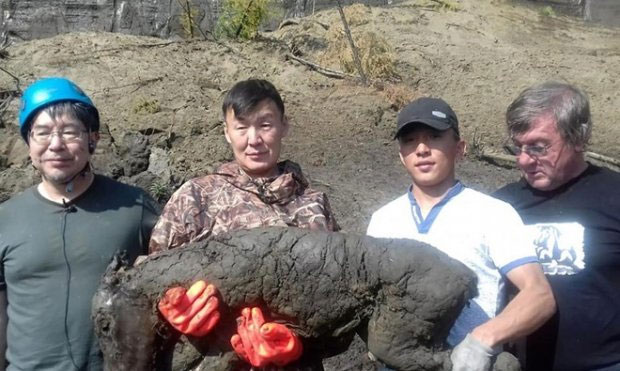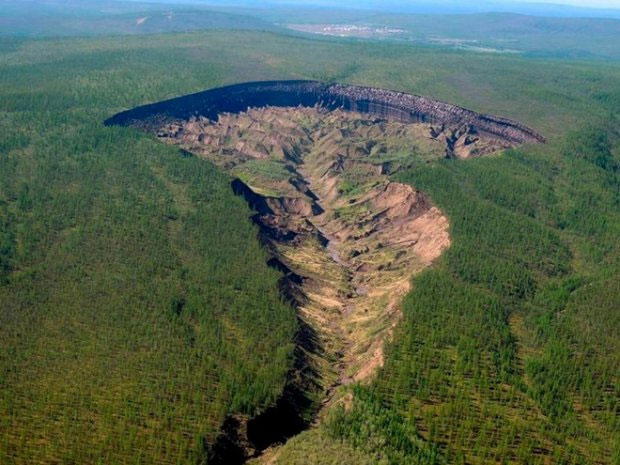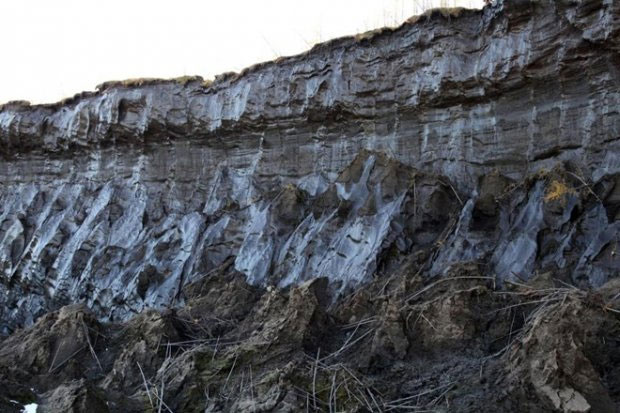Discovery of 3-month-old fossil horse in Siberia's gate of hell
Recently, scientists have discovered a dark brown fossil horse about 3 months old dating from the Stone Age and thought to be the 'most unique fossil horse in the world'.

A three-month-old fossil horse is found in Siberia.(Photo: The Sun).
This animal lies in the permafrost of the ice age and is expected to give scientists more new information about the evolution of horses.
The 3-month-old dark brown horse was found during the expedition to Verkhoyansky of Yakutia (Sakha Republic of Russia) and was dug from its grave at a depth of about 100ft (equivalent to 30.48 m) below the surface of subsidence. original

Batagaika pit is a huge hollow pit formed by permafrost.(Photo: The Sun).
A picture that the team published showed that the young horse was wrapped in mud but an account said its legs were striped like 'zebra'.
This breed is found in the Batagai sediment known as the "Hell Gate" in Siberia . This is a sprawling territory known for discovering the vestiges of extinct mammoths.
Semyon Grigoryev, the head of the world-famous Mammoth Museum in the capital Yakutsk, said: 'This horse is about 3 months old (when he dies). This unique mark is created from the permafrost of Batagai crater.
The value of this discovery has been increased many times and is the only finding that we can obtain samples of soil layers where it is preserved. This means that we will be able to restore a picture of the newly discovered young horse's habitat. '

Inside Batagai sediment.(Photo: The Sun).
This horse lived from 30,000 to 40,000 years ago and this new discovery will provide scientists with a unique and insightful look at the development of horses.
Scientists have revealed to The Siberian Times newspaper: 'We will accurately report this horse's life time after studying soil samples. The young horse was completely preserved in dark brown fur, tail and mane, as well as all internal organs.
No wound was seen on its body. This is the first time in the world that a prehistoric horse was found only 3 months old and with such a great conservation level. '
Scientists classified the Batagaika crater as megaslump , a huge hollow pit formed by permafrost. This day due to the warming of the earth's temperature, the surface soil and beneath the crater Batagaika collapsed. The study of sediments here has helped scientists discover many useful information about past changes.
- New video filmed the fearsome 'hell gate' for 50 years
- After more than 2,000 years, the mystery of the hell gate was opened
- China appears 'hell gate'
- Visit hell 'frightened' of ancient people
- Hell Gate - lake lava burning for hundreds of years
- Exploration of the gate of hell The flaming wildfire in Turkmenistan
- Visit the real
- Find 'hell gate' in myth
- Open the Mayan hell gate
- Fetal intact in fossil horses 48 million years
- 6 most terrifying landmarks in the world
- 'Hell's Gate' in Ethiopia is filled with 7km long cracks
 Discovered an ancient centipede fossil 99 million years old
Discovered an ancient centipede fossil 99 million years old Discovered bat-like dinosaurs in China
Discovered bat-like dinosaurs in China Discovered a 200-year-old bronze cannon of the coast
Discovered a 200-year-old bronze cannon of the coast Discover 305 million-year-old spider fossils
Discover 305 million-year-old spider fossils Horse Diving: A Dangerous, Cruel Sport in the 19th Century
Horse Diving: A Dangerous, Cruel Sport in the 19th Century  Top 4 legendary war horses recorded in history books
Top 4 legendary war horses recorded in history books  Illusion video causes netizens to debate: Is the horse moving closer or farther away?
Illusion video causes netizens to debate: Is the horse moving closer or farther away?  4 Challenges Every Horse Enthusiast Must Know Before Getting a Horse
4 Challenges Every Horse Enthusiast Must Know Before Getting a Horse  Akhal-Teke - The most beautiful horse in the world, with red sweat like blood
Akhal-Teke - The most beautiful horse in the world, with red sweat like blood  The Trojan Horse: Real or Legendary?
The Trojan Horse: Real or Legendary? 